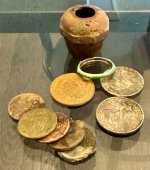piratediver
Sr. Member
I have attached an intersting blog for those who like research and archives, hopefully everyone on this board since that is where all serious wreck searches begin.
Can't wait for the water to warm up in Newport, chilly 38 now!!
http://www.nmm.ac.uk/library/2008/02/my_year_of_cataloguing.html
The great thing about working with manuscripts at the National Maritime
Museum is the various collections that you get to absorb yourself in.
Just to illustrate this, I'd like to share with you the collections that I
enjoyed last year.
One of these is the Admiralty Compass Observatory collection, which was
transferred to us from the National Archives in 1983 and includes
correspondence and reports from 1842 to 1950, residing at one of our
outstations, Kidbrooke. Through studying this area, I discovered how compass
deviation was recorded and why it was necessary to produce technical
pamphlets for modifications made to the compass over time.
This collection is wonderful for studying the history of compass
development.
Another important collection catalogued was the papers of Vice-Admiral Sir
Norman Egbert Denning. One of his 'reminiscences' involving Ian Fleming and
a smuggled Christmas tree was used as our festive item of the month for
December
What makes this collection of 67 items engaging is his involvement with Ian
Fleming and his role as the link between the operational intelligence centre
(OIC) and components of the naval intelligence division, including the
Ministry of Economic Warfare, the army, the Secret Intelligence, the Special
Operations Executive and Bomber commands of the RAF. The Admiralty aerial
photographs (1941-5) are quite fun as they reveal detailed images of convoys
and naval bases.
Another exciting collection includes journals kept by Captain Edward William
Hereford. He writes one of these as midshipman on board the Trafalgar during
the Crimean War. When I catalogued this collection I noticed how well it
would support the journals of Dr Edward Hodges Cree RN (1814-1901). Both
contain striking illustrations: within a midshipman's journal (see image
below) at the bombardment of Sevastopol in 1854 and a surgeon's account of
the capture of Sevastopol and Kinburn in 1855.
What is really inspiring is seeing the way manuscript collections can
reinforce and assist each other in terms of creating a more detailed view of
historical events. Our archive journey 'story boxes' are good examples of
how our manuscripts can be brought together thematically to bring our
collections to light.
Dive safe,
Pirate Diver
Can't wait for the water to warm up in Newport, chilly 38 now!!
http://www.nmm.ac.uk/library/2008/02/my_year_of_cataloguing.html
The great thing about working with manuscripts at the National Maritime
Museum is the various collections that you get to absorb yourself in.
Just to illustrate this, I'd like to share with you the collections that I
enjoyed last year.
One of these is the Admiralty Compass Observatory collection, which was
transferred to us from the National Archives in 1983 and includes
correspondence and reports from 1842 to 1950, residing at one of our
outstations, Kidbrooke. Through studying this area, I discovered how compass
deviation was recorded and why it was necessary to produce technical
pamphlets for modifications made to the compass over time.
This collection is wonderful for studying the history of compass
development.
Another important collection catalogued was the papers of Vice-Admiral Sir
Norman Egbert Denning. One of his 'reminiscences' involving Ian Fleming and
a smuggled Christmas tree was used as our festive item of the month for
December
What makes this collection of 67 items engaging is his involvement with Ian
Fleming and his role as the link between the operational intelligence centre
(OIC) and components of the naval intelligence division, including the
Ministry of Economic Warfare, the army, the Secret Intelligence, the Special
Operations Executive and Bomber commands of the RAF. The Admiralty aerial
photographs (1941-5) are quite fun as they reveal detailed images of convoys
and naval bases.
Another exciting collection includes journals kept by Captain Edward William
Hereford. He writes one of these as midshipman on board the Trafalgar during
the Crimean War. When I catalogued this collection I noticed how well it
would support the journals of Dr Edward Hodges Cree RN (1814-1901). Both
contain striking illustrations: within a midshipman's journal (see image
below) at the bombardment of Sevastopol in 1854 and a surgeon's account of
the capture of Sevastopol and Kinburn in 1855.
What is really inspiring is seeing the way manuscript collections can
reinforce and assist each other in terms of creating a more detailed view of
historical events. Our archive journey 'story boxes' are good examples of
how our manuscripts can be brought together thematically to bring our
collections to light.
Dive safe,
Pirate Diver




